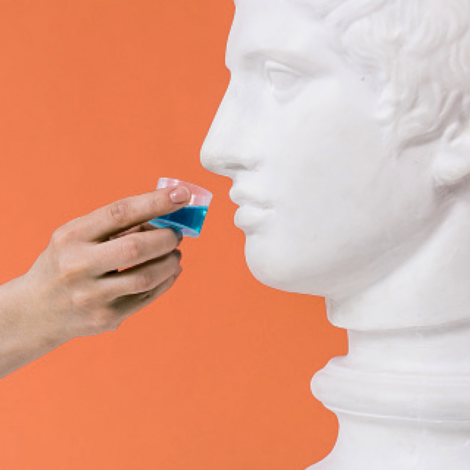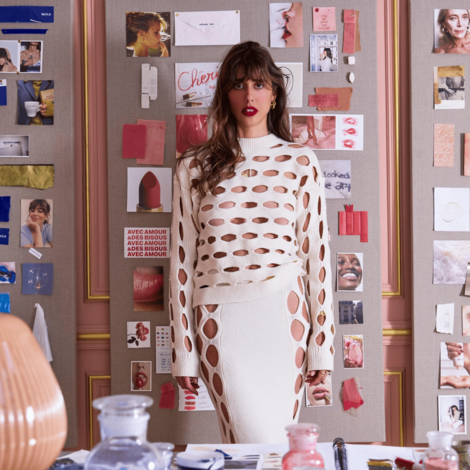Braces-clad and acne-mottled, 13-year-old me lovingly referred to MAC’s Studio Fix Powder Plus as my favorite magic trick—if nothing else, it was a clear sign I’d be a beauty writer. I’d swirl the oversize brush into the compact and stamp it emphatically on my face. For problem areas, I’d turn to a puff. Then came the rabbit-out-of-the-hat reveal: my oily forehead suddenly mattified; the tamer zits were effectively disguised. Sure, it wasn’t exactly the right shade—to be fair, it belonged to my mother—and, yes, it clung to the flakes of pimples’ past, but boy, did I feel like a woman.
As dumplings and doughnuts became beauty inspirations, my beloved pressed powders took a back seat, all but forgotten for dewier offerings. Now, after years of glazing our faces with everything creamy, makeup artists are picking up their compacts again and encouraging us to follow suit. According to Spate, a data-research firm that analyzes consumer behavior, Google searches for “pressed powder” grew by 68 percent in the last year, with a 196 percent growth on TikTok.
Trends are, by their very nature, fleeting. Powder was always bound to come back around eventually. First among its list of attributes is its simplicity. Troy Surratt, a makeup artist and founder of Surratt Beauty, considers pressed powder classic and user-friendly. “It’s the easiest and least intimidating formula,” he says.
But sometimes, the trend cycle is driven by something other than whimsy or boredom. In this case, the renaissance of pressed powder can be boiled down to an unsexy call to action: talc regulations.
When used in makeup, particularly powders, talc absorbs moisture and prevents caking. However, if it contains asbestos, talc can pose a significant health risk. The F.D.A. has been reworking proposed regulations for talc-containing cosmetics since the 2022 Modernization of Cosmetics Regulations Act, while the European Union is expected to ban talc altogether in 2027. Given talc’s starring role in pressed powder, brands have been forced back into the labs.
Within five months last year, seven prestige beauty brands launched their own talc-free pressed powders. And these aren’t the pore-clogging, cakey pressed powders of my youth.
“[Powders are] getting softer, more finely milled, and elevated in texture,” explains Katie Jane Hughes, a makeup artist and founder of KJH.brand. “Powders don’t feel like this heavy cakey finish on the face anymore.”
Today’s formulas satisfy the urge for innovation and the standards of a well-informed and skeptical audience (Alexis Androulakis, a product developer and one-half of the viral Lipstick Lesbians duo, calls it “beauty literacy”), wrapped up in purse-friendly compacts.
At the most basic level, simply replacing talc with mica and silica helps elevate the product—and not solely from a health standpoint. While more expensive than talc, they have a whole host of attractive features.
“Talc can feel heavier,” explains cosmetic chemist Ginger King. “Think of baby powder in your palm; you can see how it sits on the palm line. The use of mica and silica is more elegant.”
Silica and mica provide an unusual airiness to pressed powders, preventing particles from clumping together and sitting heavily and thickly on the surface of the skin. And then there’s the blurring effect, an attribute that Amy Liu, founder of Tower 28, says was high on the list of consumer demands when it came to creating the GetSet Blur + Set Pressed Powder. Think of silica as a real-life Instagram filter, minimizing the appearance of fine lines and uneven texture. Meanwhile, King says, mica also helps create a soft-focus effect by scattering light.
Some of the new pressed powders stop there—swapping out the talc for silica and mica and leaving it at that. Others, such as Tower 28, are taking things a step further, packing powders with skin-care ingredients like hyaluronic acid and squalane. While this makes for a great marketing angle, particularly speaking to the increasingly popular skin-care-makeup hybrids, let’s be honest: it’s not like pressed powders can really improve the skin or moisturize it in any meaningful way.
Indeed, the inclusion of emollients and humectants doesn’t necessarily yield hydration and barrier support. Instead, King explains, these ingredients improve the pressed-powder experience and prevent the drying that can often come with wearing one. That translates to smoother, creamier formulations and a more comfortable wear. In Tower 28’s case, those ingredients help make a hypoallergenic pressed powder that promises to smooth over even rough, compromised skin.
This all comes together in the ultimate pressed powder: one that blots oil without desiccating the skin, making it matte without magnifying unevenness, blurring lines and scars without looking like a layer of dust, and setting makeup without a blanket of heavy dullness.
The newest pressed powders are virtually undetectable on the skin. But if you happen to notice your pubescent child looking remarkably refined, I’d suggest checking your stash.
Danielle Cohen is a New York–based beauty writer. Her work has appeared in Elle, Allure, Glamour, and Cosmopolitan, among other publications





